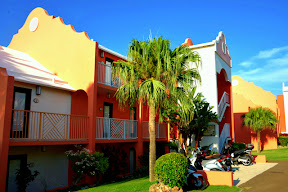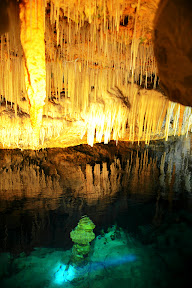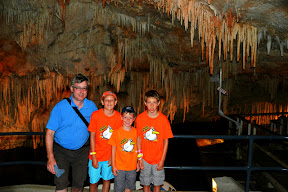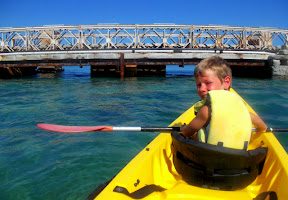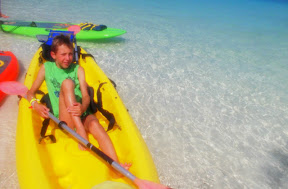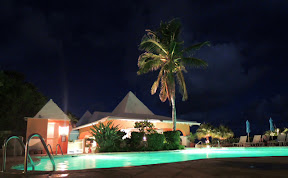
Jonah and I are up for a tour all across the islands today.

At first we take the bus to Hamilton, Bermudas capital city. At the bus terminal we wait for our bus to Horseshoe Bay.

The beach would be beautiful but...

The Norwegian Breakaway with 4000 tourists plus a second cruise ship with 2000 is on the shores of the island in Royal Naval Dockyard.

And they all seem to have travelled to Horseshoe Bay.

The ship stays for three days, then they all return to the U.S.

Jonah and I climb a big rock to get an overview.


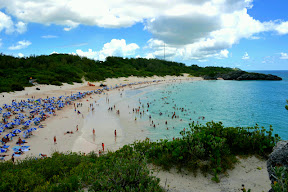
We leave the place as quick as possible and get to Gibbs Hill Lighthouse.
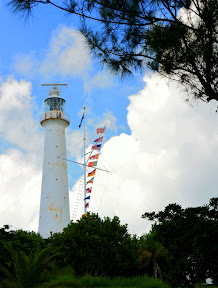
Built in 1844 by the Royal Engineers, the Gibbs Hill Lighthouse is the taller of two lighthouses on Bermuda, and the first of only a few lighthouses in the world to be made of cast-iron. This is because at that time, steel still was not able to be bent. The optic consists of a Fresnel lens from 1904 revolving on steel bearings. However for most of its history, the lens revolved on a bed of 1,200 pounds of mercury.
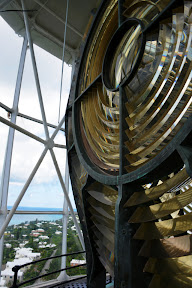
While it is certainly not extremely tall in lighthouse standards, the hill that it stands on is one of the highest on the island. The light's focal plane on Gibbs Hill Lighthouse, therefore, is at 354 feet (108 m) above sea level. Airplanes can see its flashes from over 100 miles (160 km) away. The lighthouse has 185 steps to the top in eight flights. Until 1964, most of the light was run by hand, but in June of that year, the whole system was automated and runs on electricity. Sixty-thousand people ascended the lighthouse in 1985, and it continues to be a popular tourist attraction.
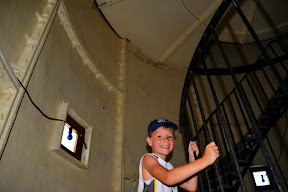
From the top of the lighthouse one can enjoy a spectacular view.

A radar antenna for marine shipping was installed atop the lighthouse in 1987 supported on a steel space frame fixed at the original bolt locations. The radar and supporting frame were undamaged in September 2003 despite the oscillation of the tower during Hurricane Fabian. This movement caused two gallons of mercury to slop out of the lens support trough and put the light out of operation. The 1904 lens was repaired in 2004 with steel bearings to replace the mercury.

We walk down the hill to find the next bus stop. The bus line 8 brings us to Royal Naval Dockyard.

HMD Bermuda (Her/His Majesty's Dockyard, Bermuda) was the principal base of the Royal Navy in the Western Atlantic between American independence and the Cold War. Bermuda had occupied a useful position astride the homeward leg taken by many European vessels from the New World since before its settlement by England in 1609. French privateers may have used the Islands as a staging place for operations against Spanish galleons in the 16th Century. Bermudian privateers certainly played a role in many Imperial wars following settlement. Despite this, it was not until the loss of bases on most of the North American Atlantic seaboard (following US independence) threatened Britain's supremacy in the Western Atlantic, however, that the Island assumed great importance as a naval base (the attendant Bermuda Garrison of the British Army existed primarily to protect the naval base).

This is the only place where the large cruise ships can moore.
Here the public transport ferry to St.George leaves. The ferry is currently undergoing repair.
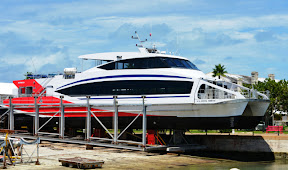
An american ferry has been rented to be able to continue the service.

We take this ferry for our round trip.

And pass by Fort St. Catherine.
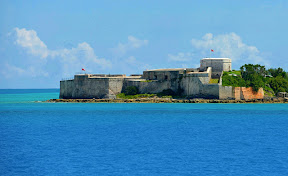

Then we come to St. George harbour. The boat tour took about 40 mins. and brought us from one end of the Bermudas to the other.


Feom St. George we take another bus back to the hotel.

(c) Dirk Frantzen 2013 — published via iPad
Position:Bermuda

